Dec 18, 2013 | Book Reviews
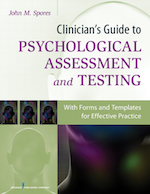 Written in a clear, concise and strategically delineated manner, The Clinician’s Guide to Psychological Assessment and Testing: With Forms and Templates for Effective Practice is written for people seeking a better understanding of various psychological tests and how those tests can inform professional practice. The author of this book, Dr. John Spores, clearly meets his stated purpose, to provide practicing clinical or counseling psychologists with a reference volume to inform their testing practice. I would note, however, that this volume can also help professionals from the fields of counseling, psychology, social work, and other related fields understand more fully how standardized psychological testing can inform their clinical work.
Written in a clear, concise and strategically delineated manner, The Clinician’s Guide to Psychological Assessment and Testing: With Forms and Templates for Effective Practice is written for people seeking a better understanding of various psychological tests and how those tests can inform professional practice. The author of this book, Dr. John Spores, clearly meets his stated purpose, to provide practicing clinical or counseling psychologists with a reference volume to inform their testing practice. I would note, however, that this volume can also help professionals from the fields of counseling, psychology, social work, and other related fields understand more fully how standardized psychological testing can inform their clinical work.
In order to do this, Dr. Spores has divided his book into three parts. The first section reviews the process of psychological assessment and standardized testing. In the introductory chapter, he makes a clear and convincing case for the use of standardized psychological testing as a way to augment and sometimes even surpass clinical interviews. Most helpful is his delineation of how the process of testing should be done and what events need to happen for the process to be done correctly. The author is also an attorney, and this comes out in the straightforward and step-wise manner in which he describes this process.
In the first section, the reader is introduced to one of the most useful aspects of this book. The author has provided numerous forms and templates for each of the processes for psychological testing. It should be noted that the author’s in-text references to the provided forms and templates are extremely helpful. For example, when the author writes about how referral sources make a referral for testing, he provides an excellent example at the end of the chapter of a “Psychological Test Referral Form.” This is consistent throughout the book. When the author references a form or report of some type, he provides an example of that form or report at the end of the chapter. This gives readers a concrete example, something they can immediately reference to understand the ideas and concepts discussed in this guide. This invaluable resource is also available in electronic format on the publisher’s Web site.
The author continues to inform the reader in section two with concrete examples of the standardized tests used in psychological testing. Divided into subsections, the section provides the reader with information about widely known and utilized tests in the following areas: (1) intelligence tests; (2) achievement tests; (3) neuropsychological tests; (4) symptom rating scales; (5) self-report clinical and personality inventories; (6) examiner-administered personality tests; and (7) adaptive behavior tests. To help clinicians even better understand the process of selecting and administering these types of tests, each subsection has four parts: a description of the construct being measured; the diagnostic reasons for conducting such a test; insurance billing and coverage issues; and examples of common tests used to measure the described construct. The author is clear that the example tests he lists are those that he likes to use for measuring a described construct, and he gives compelling reasons why he believes that they are appropriate choices.
In the final section, section three, the author provides specific case examples of children, adolescents and adults for whom standardized tests have served as a means of identifying areas of clinical concerns. These vital case examples demonstrate how the testing process can work to a clinician’s advantage in providing the best care for clients.
The only caveat to this book is that Dr. Spores assumes that the reader is trained in diagnostic interviewing, psychometrics, and administering and scoring the tests presented and discussed in this book. Accordingly, those readers who are not familiar with the common standardized tests presented in this book (e.g., Wechsler tests, Minnesota Multiphasic Personality Inventory, Rorschach) may find themselves at a disadvantage. Dr. Spores does acknowledge his assumption in the Introduction, and those readers who are not familiar with these tests may benefit from some additional reading and training before attempting to utilize this guide.
Overall, this is an excellent guide to the use and administration of psychological tests. It provides straightforward directions and instructions on how to utilize testing in such a way as to better inform clinical practice. I could see this book as a mainstay on any counselor’s bookshelf, especially those who are seeking a way to utilize standardized testing in their practice.
Spores, J. M. (2013). Clinician’s guide to psychological assessment and testing: With forms and templates for effective practice. New York, NY: Springer.
Reviewed by: Joseph P. Jordan, North Carolina Physicians Health Program and North Carolina Veterinary Health Program, Raleigh, NC.
The Professional Counselor Journal
HOME PAGE
Sep 17, 2013 | Book Reviews
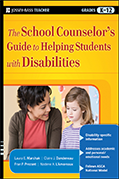 The insight, information and strategies provided in the book, The School Counselor’s Guide to Helping Students with Disabilities, are valuable resources for practicing school counselors and counselor educators. The book offers strategies for meeting the needs of students with disabilities more effectively.
The insight, information and strategies provided in the book, The School Counselor’s Guide to Helping Students with Disabilities, are valuable resources for practicing school counselors and counselor educators. The book offers strategies for meeting the needs of students with disabilities more effectively.
The School Counselor’s Guide to Helping Students with Disabilities is divided into three parts. Part 1 provides foundational knowledge for school counselors and helps readers integrate information about disabilities into their counseling programs. Chapter 1 highlights school counselors’ roles regarding students with disabilities and explains the specialized developmental needs of such students as compared to their peers. Chapter 2 discusses common assumptions about students with disabilities and provides tools to help counselors interact with the students’ families more effectively. Chapter 3 explains how to transform a traditional school counseling program into one that facilitates competency development for students with disabilities. This chapter also provides information on including students with disabilities in school counseling programs and offers leadership and advocacy guidelines for school counselors. Chapter 4 explains the school counselor’s role in the individualized education program (IEP), Section 504, Plans and Transition Plans. Chapter 5 provides ways for school counselors to form effective partnerships with parents and highlights frequent experiences, feelings and realities of parents of children with disabilities, based on the authors’ experiences and knowledge.
Part 2 of the book focuses on the academic, personal/social and career domains from the American School Counselor Association (ASCA). Chapter 6 discusses ways in which school counselors play a crucial role in addressing the academic needs of students with disabilities, and it includes methods that help teachers create positive learning environments for students. Chapters 7 and 8 examine students’ social and personal needs, focusing on the effects of peer relationships. These chapters also include strategies for school counselors that promote social integration within schools. While describing the central needs and challenges of children with disabilities, Chapter 9 concentrates on the importance of career education and development. It also gives guidelines on preparing students for the transition from school to work, training or higher education.
Part 3 delivers practical information about disabilities, as detailed within each category of the Individuals with Disabilities Education Act (IDEA). For each disability, the authors provide general information; what students and parents with the disability wish teachers and school counselors knew; practical applications in each of the ASCA domains; and resources containing more information about the specific disability.
The collective knowledge and experience of the authors, who are expert school counselors, make this book rich in valuable content. As a future school counselor, I find that this book provides fundamental resources for assisting students with disabilities. The information in this book soundly represents the ASCA domains for future school counselors. Reading this book would benefit educators, parents and anyone interested in working alongside students with disabilities.
Marshak, L. E., Dandeneau, C. J., Prezant, F. P., & L’Amoreaux, N. A. (2010). The School Counselor’s Guide to Helping Students with Disabilities. New York, NY: Springer Publishing Company.
Reviewed by: Estefanía Riveros, Miami, Florida.
The Professional Counselor Journal
HOME PAGE
May 20, 2013 | Book Reviews
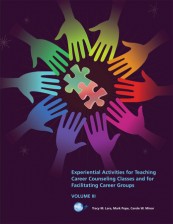 The experiential activities in Experiential Activities for Teaching Career Counseling Classes and for Facilitating Career Groups are an invaluable tool in the counseling field. It is a comprehensive and didactic approach to career counseling for the counselor educator.
The experiential activities in Experiential Activities for Teaching Career Counseling Classes and for Facilitating Career Groups are an invaluable tool in the counseling field. It is a comprehensive and didactic approach to career counseling for the counselor educator.
Each chapter is well organized in clearly stating purpose, learning objectives, application of theory, target population, setting, materials needed and instructions. The content identifies key areas in career counseling consisting of theoretical orientations in counselor education development, assessment tools, pragmatic exercises and technological resources. The self-knowledge exercises help the counselor educator in resolving one’s ambivalence in making sound career choices.
Lara, Pope and Minor incorporate practical lessons that make learning interesting and educational. Important aspects of counselor education have been covered in the book through group activities that enhance self-awareness, knowledge and broaden one’s worldview. The ‘Order in Chaos’ exercise allows an opportunity for counselor educators to perceive the complexities and patterns in career development. The assessments help identify values that counselor educators could incorporate into their training. The importance of networking is highlighted to help future employees in their job search. The exercises focus on preparing future employees in obtaining gainful employment and a successful career path. The book lists various technologies available to counselors to provide vital information and update their knowledge of current research trends in the field of career counseling.
This pragmatic guide for counselor educators reaches out to a diverse population. With an emphasis on career development, the book plays a significant role in helping future counselors with job readiness, which is very vital in today’s fast paced world. Gaining knowledge from the book, counselors can become self-confident and motivated in performing effectively in their profession.
Throughout the book, the authors accentuate core competencies of counselor education. In the reflections and evaluations, the reader can discern several significant concepts in counselor education. Thought provoking objectives, case scenarios and discussion questions throughout the book give the reader a better understanding of each topic rather than learning the material by rote. With limited research available on group counseling, the book guides counselors from all related fields to help clients resolve their problems. The counselor-client relationship is fostered in mutual learning of acceptance, empathy and respect in their interaction. I think this well-written and easily comprehensible book will help educators utilize a hands-on approach in teaching without undermining the theoretical element in counseling. Using assessment tools and practical exercises help in determining the individual’s strength and interests.
Experiential Activities for Teaching Career Counseling and For Facilitating Career Groups is a must read book for every counselor educator. The book aims at teaching the material in an interesting manner, while educating counselors to be better clinicians and well-rounded individuals. It is designed in a universally structured educational framework with the objective of producing creative and ethical individuals that value integrity in a progressive world.
Lara, T., Pope, M., & Minor, C. (2011). Title . Broken Arrow, OK: National Career Development Association.
Reviewed by: Shanti Nair, doctoral counseling student, Barry University, Miami Shores, Florida.
The Professional Counselor Journal
https://tpcwordpress.azurewebsites.net
Apr 19, 2013 | Book Reviews
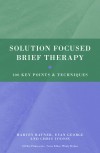 Ratner, George, and Iveson’s Solution Focused Brief Therapy: 100 Key Points Techniques, direct BRIEF, a coaching, therapy, training, and consulting center in London which currently happens to be the largest brief therapy training center in the world. The authors’ vast Solution Focused Brief Therapy (SFBT) experience is highlighted throughout the text.
Ratner, George, and Iveson’s Solution Focused Brief Therapy: 100 Key Points Techniques, direct BRIEF, a coaching, therapy, training, and consulting center in London which currently happens to be the largest brief therapy training center in the world. The authors’ vast Solution Focused Brief Therapy (SFBT) experience is highlighted throughout the text.
Supplied in an easy to read format, Solution Focused Brief Therapy: 100 Key Points & Techniques offers multiple relevant clinical case vignettes to guide the reader through the 100 points and techniques. The case examples are highly nuanced, further demonstrating the authors’ mastering of solution focused brief therapy and increasing the value and utility of the book. Solution focused practitioners search for instances of success in client’s lives, whereby creating new dialog outside of problem focused talk. In solution focused practice, common questions are those of difference: ‘What has worked in the past?’, ‘What difference are you hoping that will make?’, and ‘Who else would notice that coming here has been useful for you?’. Point 66 of 100 is a direct example; under the part on conducting follow-up sessions, subtitled, When the client says things are worse , the authors write: “There will be a time when every solution focused brief therapist asks [the client(s)], ‘so what has been better’ and the client will answer ‘you’re joking surely, it’s been worse, ten times worse. This week has been the worst week of my life’. While it can be tempting for the panicky counselor to try to trick the client out of his position [by responding] ‘but you got yourself here – how did you manage that?’. This statement from the practitioner contains the underlying logic of ‘if things were really so bad you wouldn’t be here, but you are here so it cannot be that bad’. The authors suggest this approach is always worth avoiding, because it does not validate the client’s difficulty before redirecting the conversation. This short clinical example is one of many housed within the 100 points in this text.
Solution Focused Brief Therapy: 100 Key Points & Techniques contains 16 parts which are further subdivided by the 100 key points and techniques. The authors begin Part I with the background of SFBT by discussing the Mental Research Institute in Milwaukee, social construction by Ken Gergen, Wittgenstein and his famous language games, and collaborative approaches to counseling. Part I ends with the assumptions of the client-counselor relationship, change processes, key assumptions, and an outline of first session goals. Part II describes compliments, taking turns in speech and acknowledging possibility. Part III, subtitled ‘Getting Started’ describes the beginning of therapy, techniques, and vital information to begin SFBT including a ‘resource audit.’
Part IV focuses on establishing a contract, or the joint project. The joint project function is finding the client’s best hopes from counseling, with guidelines for establishing a contract with involuntary clients and young clients. The authors describe the difference between outcome and process wherein the contract must contain a true ‘in-life’ difference versus working with a goal of ‘I just want to get things off my chest’. Part V describes broadening and detailing the client’s preferred future by the tomorrow question a derivative of the miracle question, and five key points to help the practitioner in defining and detailing preferred futures. Part VI describes exceptions, no exceptions and creating resource lists.
Part VII details the scaling techniques to measure progress, and practitioners helping clients to move up the scale. Part VIII outlines coping questions during difficult client stories and what to do during difficult sessions with issues such as bereavement. Part IX describes the role of the SFBT therapist during the termination process with Part X examining the follow-up sessions. Part XI is tailored to ending the work with clients, while XII is dedicated to assessment within SFBT. The next two sections are handling specific populations such as children, families, group work and adults. Part XV is dedicated to supervision, coaching, and organizational uses, with the last subtitle Part XVI answering frequently asked questions. This book is a worthy addition to any counselor’s bookshelf.
Ratner, H., George, E., & Iveson, C. (2012) . Solution focused brief therapy: 100 key points and techniques. New York, NY: Routledge.
Reviewed by: George E. Harrington III, doctoral counseling student, Barry University, Miami Shores, Florida.
The Professional Counselor Journal
HOME PAGE
Mar 20, 2013 | Book Reviews, Non-English Texts
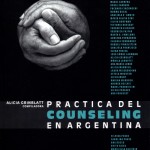 Alicia Grinblatt (2008) ha compilado las experiencias de 48 counselors Argentinos. Siendo ella misma una Counselor, ha logrado capturar el trabajo anónimo que los consejeros realizan día a día (p.11). El libro está dividido en 13 áreas incluyendo adicciones, sexualidad, supervisión, y counseling educacional, entre otros. Andrés Sánchez Bodas (p. 15) remarca que cada texto en el libro emerge de la práctica profesional. Cada capítulo provee la representación del estado del Counseling en el país acorde con las experiencias de su autor; su pasión por la profesión, y sus expectativas para el futuro.
Alicia Grinblatt (2008) ha compilado las experiencias de 48 counselors Argentinos. Siendo ella misma una Counselor, ha logrado capturar el trabajo anónimo que los consejeros realizan día a día (p.11). El libro está dividido en 13 áreas incluyendo adicciones, sexualidad, supervisión, y counseling educacional, entre otros. Andrés Sánchez Bodas (p. 15) remarca que cada texto en el libro emerge de la práctica profesional. Cada capítulo provee la representación del estado del Counseling en el país acorde con las experiencias de su autor; su pasión por la profesión, y sus expectativas para el futuro.
El libro cubre una variedad de áreas, poblaciones y escenarios. Todas las secciones incluyen discusiones sobre el tema, estrategias usadas para abordarlo, y las experiencias de los counselors en el campo. Algunos capítulos enfatizan la descripción de experiencias de campo; Claudia Fernández (p. 57) escribió acerca de los sentimientos y experiencias de personas con esclerosis múltiple; sus dificultades en la búsqueda de ayuda y su necesidad de sentirse apoyados. Fernández proyecta una vida de servicio y la inspiración por hacer la diferencia en la vida de otros. Silvia Perazzo (p. 100) también describe sus experiencia personales; expresa de manera genuina sus dudas, retos, y su recorrido profesional en el trabajo con niños. Su historia es un ejemplo de determinación y crecimiento personal; un camino de auto-descubrimiento profesional, una búsqueda continua de respuestas y recursos, y una vida construyendo relaciones de apoyo. Otros autores comparten estrategias específicas que están siendo usadas en Argentina. María Felisa Díaz (p. 31) describe un proyecto de inclusión social para adolescentes; Mabel Carrera, Rosel Carrere y Federico Elizalde (p. 23) describen un proceso de consejería de grupo ofrecida a personas que han sido liberadas de prisión; Silvia Mount (p.71) presenta una propuesta educativa usada en una institución de educación pre-escolar; y Verónica Peluffo de Apellaniz (p. 122) explica su trabajo con talleres de prevención de adicciones basados en niveles de comunicación y grupos de apoyo. Estos y muchos otros capítulos del libro constituyen un buen recordatorio de la relevancia del Counseling, la necesidad de la profesión y su impacto en la vida de las personas.
Algunos capítulos se refieren a temas más específicos. María Teresa Toscano (p. 112) explica el significado del término familias ensambladas; familias que han surgido de segundos matrimonios o uniones, donde todos los miembros de la familia tienen que conocerse unos a otros y construir un futuro juntos. Graciela B. Francisco (p. 134) discute el tema de adicciones en adolescentes y las necesidades de sus padres; la importancia de la dinámica familiar y estrategias para consejeros que trabajan con esas familias. Raquel Finkelstain (p. 163) introduce el tema de negocios familiares desde una perspectiva del counseling organizacional, y las dificultades que surgen de la dinámica entre las relaciones personales y los roles profesionales establecidos. Todos temas pertine
El libro Practica del Counseling en Argentina incluye una variedad tan amplia de tópicos que se hace imposible incluirlos todos en esta breve revisión. Sin embrago, se espera que los fragmentos seleccionados sirvan como una guía de temas a explorar; como reflexión acerca de los posibles usos del libro; y como un motivador para considerar este recurso bibliográfico. Es además importante mencionar que a pesar de que el libro ha sido escrito con base en el enfoque Centrado en la Persona, incluye además una sección completa que explora otros enfoques tales como Gestalt y Psicodrama; además de un numero de estrategias creativas que incluyen el trabajo con sonidos, expresiones orales, y conciencia corporal entre otros. ntes e innovadores en el campo del Counseling.
El libro Practica del Counseling en Argentina es una inspiración para todo counselor. Profesionales novatos pueden informarse acerca de los sentimientos, expectativas, y retos que todo Counselor tiene al inicio de su carrera profesional; Mientras que Counselors con más experiencia en el campo pueden utilizar este libro como una herramienta para relacionarse con otros e informarse acerca de las nuevas tendencias del Counseling en Argentina. Por otra parte, counselors expertos también pueden hacer uso de esta compilación de conocimientos y experiencias profesionales en el campo, para futuros proyectos de investigación y práctica. La esencia de este trabajo es capturada por Silvia Munt (p.70) con su frase: “Hay tanto por hacer… y yo solo tengo dos manos… que se pueden entrelazar con otras y otras y así formar redes que contengan…”
Grinblatt, A. (Ed.). (2008). Práctica del counseling en Argentina. Buenos Aires, Argentina: Georges Zanun Editores.
Revisado por:, Consejera Certificada en los Estados Unidos (NCC), estudiante de doctorado, Universidad Estatal de Carolina del Norte, Raleigh, Carolina del Norte.
The Professional Counselor
https://tpcwordpress.azurewebsites.net
Feb 25, 2013 | Book Reviews
 The first section of the book, Understanding and Promoting Healthy Development, focuses on the developmental issues affecting males from birth to adulthood. Although the authors briefly mention females in the section, males and their distinctiveness are further explored and explained. Males tend to benefit from therapeutic modalities catered towards action and activity. Furthermore, creating a supportive therapeutic milieu and avoiding interventions detrimental to the client’s progress, is integral. As part of the focus on developmental issues, the book discusses the intellectual range within the male population, from the gifted to persons with learning disabilities. Indubitably, understanding the nuances of the male species provides a greater opportunity to encourage boys and young men towards therapeutic goals.
The first section of the book, Understanding and Promoting Healthy Development, focuses on the developmental issues affecting males from birth to adulthood. Although the authors briefly mention females in the section, males and their distinctiveness are further explored and explained. Males tend to benefit from therapeutic modalities catered towards action and activity. Furthermore, creating a supportive therapeutic milieu and avoiding interventions detrimental to the client’s progress, is integral. As part of the focus on developmental issues, the book discusses the intellectual range within the male population, from the gifted to persons with learning disabilities. Indubitably, understanding the nuances of the male species provides a greater opportunity to encourage boys and young men towards therapeutic goals.
Seemingly, dyadic relationships are significant in the development of young men. Relationship Development and Relationship Concerns, the second section of the book, examines the complexities of young males’ interpersonal relationships. Family dynamics, romantic involvement, and sexual identity are the topics discussed in the aforementioned section. Accordingly, the authors elucidate the varying degrees of relationship issues and provide practical techniques for assisting males with these issues.
Emotional and Mental Health Concerns and Behavior Disorders and Concerns, the final sections of the text, outline the pervasiveness of mental health issues and the affects of conduct related behavioral disorders among young males. Presumably, young men tend to be commonly diagnosed with inattentive and conduct related disorders. Despite the apparent ubiquitous nature of specific disorders affecting young males, the authors assert specific treatment modalities may alleviate the therapeutic process. Moreover, environmental aspects of an individual’s life are certainly contributory factors to potential disorders. Thus, exploring ancillary aspects of young males’ lives is imperative in examining potential treatment avenues.
Counseling Boys and Young Men provides a plethora of information and counseling techniques essential to the continued development of young men. The counseling nomenclature is accurate and serves as a point of reference for novice and experienced counselors alike. The book offers a chapter on adolescent diversity; however, multicultural issues and the significance of distinctiveness could be further explored. The text serves as a noteworthy manual addressing the myriad of issues affecting young males in today’s society.
Degges-White, S., & Colon, B. (2012). Counseling Boys and Young Men. New York, NY: Springer Publishing Company.
Reviewed by: Jadarius Jackson, graduate student, North Carolina A&T State University, Greensboro, North Carolina.
The Professional Counselor Journal
HOME PAGE
 Written in a clear, concise and strategically delineated manner, The Clinician’s Guide to Psychological Assessment and Testing: With Forms and Templates for Effective Practice is written for people seeking a better understanding of various psychological tests and how those tests can inform professional practice. The author of this book, Dr. John Spores, clearly meets his stated purpose, to provide practicing clinical or counseling psychologists with a reference volume to inform their testing practice. I would note, however, that this volume can also help professionals from the fields of counseling, psychology, social work, and other related fields understand more fully how standardized psychological testing can inform their clinical work.
Written in a clear, concise and strategically delineated manner, The Clinician’s Guide to Psychological Assessment and Testing: With Forms and Templates for Effective Practice is written for people seeking a better understanding of various psychological tests and how those tests can inform professional practice. The author of this book, Dr. John Spores, clearly meets his stated purpose, to provide practicing clinical or counseling psychologists with a reference volume to inform their testing practice. I would note, however, that this volume can also help professionals from the fields of counseling, psychology, social work, and other related fields understand more fully how standardized psychological testing can inform their clinical work.
 Ratner, George, and Iveson’s Solution Focused Brief Therapy: 100 Key Points Techniques, direct BRIEF, a coaching, therapy, training, and consulting center in London which currently happens to be the largest brief therapy training center in the world. The authors’ vast Solution Focused Brief Therapy (SFBT) experience is highlighted throughout the text.
Ratner, George, and Iveson’s Solution Focused Brief Therapy: 100 Key Points Techniques, direct BRIEF, a coaching, therapy, training, and consulting center in London which currently happens to be the largest brief therapy training center in the world. The authors’ vast Solution Focused Brief Therapy (SFBT) experience is highlighted throughout the text.
 The first section of the book, Understanding and Promoting Healthy Development, focuses on the developmental issues affecting males from birth to adulthood. Although the authors briefly mention females in the section, males and their distinctiveness are further explored and explained. Males tend to benefit from therapeutic modalities catered towards action and activity. Furthermore, creating a supportive therapeutic milieu and avoiding interventions detrimental to the client’s progress, is integral. As part of the focus on developmental issues, the book discusses the intellectual range within the male population, from the gifted to persons with learning disabilities. Indubitably, understanding the nuances of the male species provides a greater opportunity to encourage boys and young men towards therapeutic goals.
The first section of the book, Understanding and Promoting Healthy Development, focuses on the developmental issues affecting males from birth to adulthood. Although the authors briefly mention females in the section, males and their distinctiveness are further explored and explained. Males tend to benefit from therapeutic modalities catered towards action and activity. Furthermore, creating a supportive therapeutic milieu and avoiding interventions detrimental to the client’s progress, is integral. As part of the focus on developmental issues, the book discusses the intellectual range within the male population, from the gifted to persons with learning disabilities. Indubitably, understanding the nuances of the male species provides a greater opportunity to encourage boys and young men towards therapeutic goals.